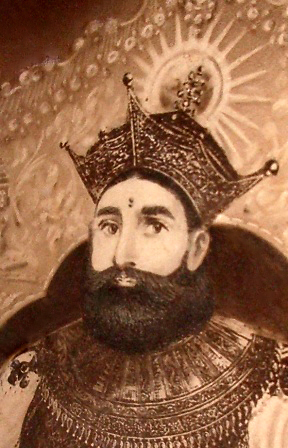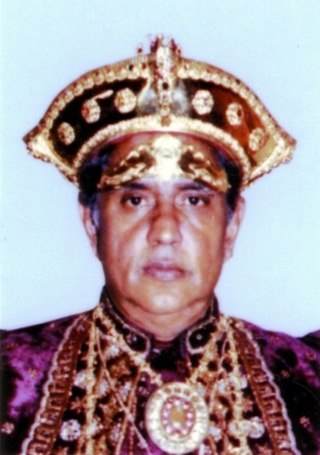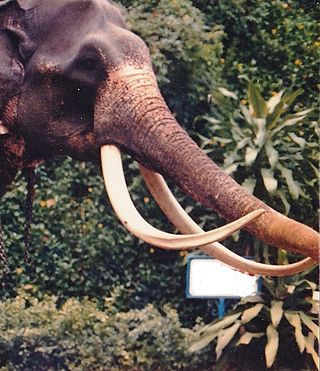
Kandy is a major city in Sri Lanka located in the Central Province. It was the last capital of the ancient kings' era of Sri Lanka. The city is situated in the midst of hills in the Kandy plateau, which crosses an area of tropical plantations, mainly tea. Kandy is both an administrative and religious city and is also the capital of the Central Province. Kandy is the home of the Temple of the Tooth Relic, one of the most sacred places of worship in the Buddhist world. It was declared a world heritage site by UNESCO in 1988. Historically the local Buddhist rulers resisted Portuguese, Dutch, and British colonial expansion and occupation.

King Rajasinghe II, also known as Rajasingha II, was a Sinhalese King, reigned 1629 – 6 December 1687; seventh king of the Kingdom of Kandy in Sri Lanka. Rajasingha requested Dutch aid to help expel the Portuguese from the island, which they successfully did in 1656. By this time however it had become clear to the Kandyans that the Dutch not only intended to expel the Portuguese but to replace them as the major colonial power on the island. This transfer of power is also believed to be where the Sinhala idiom / figure of speech “ඉඟුරු දී මිරිස් ගත්තා වාගේ” Inguru di miris gaththa wagay was originated - in reference that the Dutch Rule was much more of a menace to the king and cruel to the people in the island than the Portuguese. From 1645 onwards Rajasingha was engaged in sporadic warfare with his erstwhile allies.

The Kandy Esala Perahera also known as The Festival of the Tooth is a festival held in July and August in Kandy, Sri Lanka. This historical procession is held annually to pay homage to the Sacred Tooth Relic of Buddha, which is housed at the Sri Dalada Maligawa in Kandy. A unique symbol of Sri Lanka, the procession consists of traditional local dances such as fire dances and performances in whip-dance garments. The festival ends with the traditional Diya-kepeema ritual, a water cutting ceremony which is held at the Mahaweli River at Getambe, Kandy.

Sri Vikrama Rajasinha was the last of four Kings to rule the last Sinhalese monarchy of the Kingdom of Kandy in Sri Lanka. The Nayak Kings were of Telugu origin and practiced Shaivite Hinduism and were patrons of Theravada Buddhism. The Nayak rulers played a huge role in reviving Buddhism in the island. They spoke Telugu and Tamil, and used Tamil as the court language in Kandy alongside Sinhala.

Deshamanya Nissanka Parakrama Wijeyeratne, known as Nissanka Wijeyeratne, was a Sri Lankan politician, civil servant, diplomat and English language poet. He was also the Diyawadana Nilame of the Sri Dalada Maligawa, Kandy from 1975 to 1985. At the time of death he was serving as the chairman of The Law and Society Trust in Sri Lanka.

Diyawadana Nilame is the office of the chief lay custodian of the Temple of the Tooth, Kandy, Sri Lanka. Formerly an office of the royal household, at present it is the trustee for the Temple of the Tooth as defined by the Buddhist Temporalities Ordinance of 1931. A ceremonial position, enriched with over two thousand years of history to protect and carry out ancient rituals for the relic of the tooth of the Buddha. The Diyawadana Nilame recognised as a states man has the responsibility of overseeing of all aspects of the Sri Dalada Maligawa. He has the traditional duty of organizing the annual pageant, the Kandy Esala Perahera. The current Diyawadana Nilame is Pradeep Nilanga Dela.

Neranjan Priyadarshana Dullewe Wijeyeratne is a Sri Lankan. He was Diyawadana Nilame of the Sri Dalada Maligawa, Kandy for 20 years from 1985 to 2005. Wijeyeratne was former United National Party politician and ex chief organiser for the Galagedara Electorate in Kandy District and former Leader of the Opposition in the Kandy Municipal Council.

The Royal Palace of Kandy, located to the north of the Temple of the Tooth in Kandy, was the royal residence of the Sri Lankan monarchy of the Kingdom of Kandy in Sri Lanka. The last king to reside in it was King Sri Vikrama Rajasinha (1798–1815).

The Temple of the Sacred Tooth Relic or Sri Dalada Maligawa, is a Buddhist temple in Kandy, Sri Lanka. It is located in the royal palace complex of the former Kingdom of Kandy, which houses the relic of the tooth of the Buddha. Since ancient times, the relic has played an important role in local politics because it is believed that whoever holds the relic holds the governance of the country. The relic was historically held by Sinhalese kings. The temple of the tooth is a World Heritage Site mainly due to the temple and the relic.

Raja was a Sri Lankan tusker elephant belonging to the Sri Dalada Maligawa, Kandy. Raja participated at the annual Esala procession in Kandy for around 50 years and was the sacred casket bearer of the final Randoli perehera for 37 years. He was one of the most celebrated elephants in Asia during his lifetime, and was world famous for his noble behavior. On 20 August 1986 former Sri Lankan President J. R. Jayewardene declared Raja as a national treasure, in recognition of his valuable services to the religion and culture of Sri Lanka.
1989 Temple of the Tooth attack is an attack on the Temple of the Tooth Relic, located in Kandy, Sri Lanka. The shrine, which is considered to be important to the Buddhists in Sri Lanka, houses the relic of the tooth of the Buddha, and is a UNESCO designated World Heritage Site. It was attacked on 8 February 1989 unknown military group in Sri Lanka.

1998 Temple of the Tooth attack is an attack on the Temple of the Tooth Relic, located in Kandy, Sri Lanka. The shrine, which is considered to be important to the Buddhists in Sri Lanka, houses the relic of the tooth of the Buddha, and is also a UNESCO designated World Heritage Site. In 1998, it was attacked by Liberation Tigers of Tamil Eelam (LTTE), a separatist militant organization which fought to create an independent Tamil state in Northern and Eastern parts of the country, from 1983 to 2009.

Heiyantuduwa Raja (1924-November 6 2002) was a Sri Lankan elephant, which carried the Relic of the tooth of the Buddha casket in the Dalada Perahera for 11 years after the demise of Maligawa Raja. Heiyantuduwa Raja's tusks were each 7 ft 6 in (2.3 m) in length when he was living, and it was considered one of the longest-tusked elephants in the country.

Temple of the Tooth Museum is a museum of the Temple of the Tooth. It is located on the first and the second floors wing of the Temple of the Tooth in Kandy, Sri Lanka.

The Golden Canopy of the Temple of the Tooth is a canopy used to cover the Relic of the tooth of the Buddha, housed in the Sri Dalada Maligawa in Kandy Sri Lanka.

Malwathu Maha Viharaya is a Buddhist monastery located in Kandy, Sri Lanka. It is the headquarters of the Malwatta chapter of Siyam Nikaya and one of the two Buddhist monasteries that holds the custodianship of sacred tooth relic of Buddha kept in Sri Dalada Maligawa, Kandy. The chief incumbent of the Malwathu Maha Viharaya is the Mahanayaka thero of Malwatta chapter of Siyam nikaya, a leading Buddhist monastic fraternity in Sri Lanka. The present chief incumbent of Malwathu Maha Viharaya is Thibbatuwawe Sri Siddhartha Sumangala Thero.
Asgiri Maha Viharaya is a Buddhist monastery located in Kandy, Sri Lanka. It is the headquarters of the Asgiriya chapter of Siyam Nikaya, one of the two Buddhist monasteries that holds the custodianship of sacred tooth relic of Buddha kept in Sri Dalada Maligawa, Kandy. The chief incumbent of the Asgiri Maha Viharaya is the Mahanayaka thero of Asgiri chapter of Siyam nikaya, a leading Buddhist monastic fraternity in Sri Lanka. The present chief incumbent of Asgiri Maha Viharaya is Venerable Warakagoda Sri Gnanarathana Thero. Asgiri Maha Vihara traces its origin from the Wanavasi sect of the Dimbulagala forest monastery of Polonnaruva. Currently, 565 Buddhist temples in Sri Lanka function under Asgiri Viharaya of Kandy.

The Kandyan period covers the history of Sri Lanka from 1597–1815. After the fall of the Kingdom of Kotte, the Kandyan Kingdom was the last Independent monarchy of Sri Lanka. The Kingdom played a major role throughout the history of Sri Lanka. It was founded in 1476. The kingdom located in the central part of Sri Lanka managed to remain independent from both the Portuguese and Dutch rule who controlled coastal parts of Sri Lanka; however, it was colonised by the British in 1815.

The Empire Hotel, Kandy or Olde Empire Hotel, is a small two-storey heritage hotel located on Temple Road in the Kandy city centre.
Indi Raja, also known as Indi Raja tusker, is an Indian elephant. The tusker is one of the main casket bearers of the Kandy Esala Perahera, an annual procession held to pay homage to the Sacred Tooth Relic of Buddha, at the Temple of the Tooth in Kandy, Sri Lanka, in which he carried the main casket for most number of times. He is also the leading tusker of the elephant troop at the Temple of the Tooth.

















